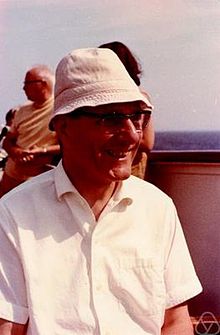Hans Maaß (mathematician)
Hans Maaß (born June 17, 1911 in Hamburg , † April 15, 1992 in Heidelberg ) was a German mathematician who dealt with function theory.
Live and act
Maaß grew up in Hamburg, where he lost his father early in the First World War and was raised by his mother, who made it possible for him to study despite his modest income. He initially studied physics and astronomy at the University of Hamburg with the aim of becoming an astronomer. While reading the celestial mechanics book Theoria Motu by Carl Friedrich Gauß , he came across continued fractions , studied the textbook by Oskar Perron and thus came to mathematics. He studied in Hamburg with Emil Artin , under whose influence his first publication was made in 1937, and Erich Hecke , from whom he received his doctorate in 1937 with his thesis "Construction of entire modular forms of half-integer dimensions with multipliers in one and two variables".
From 1935 to 1938 Maaß was a member of the National Socialist Motor Corps (NSKK) and joined the NSDAP in 1937 . In 1939 he went after a short time as a structural engineer in the aircraft industry ( Focke-Wulf in Bremen) to the Ruprecht-Karls-Universität Heidelberg , where after his habilitation in 1940 ("On the theory of automorphic functions of n changeable", Mathematische Annalen 1940) he was a private lecturer was. During the war he continued to give lectures in Heidelberg, but also carried out fluid mechanics and static calculations for the Luftwaffe and, towards the end of the war , was captured by the Americans as a member of the Luftwaffe's weather service , but was released at the end of 1945 and resumed his lectures. From 1948 he was associate professor and from 1958 professor in Heidelberg, after he had turned down a call to Göttingen at Siegel's invitation. He was several guest stays at the Tata Institute of Fundamental Research in Bombay (1954/5, 1962/3). He was dean of the Faculty of Mathematics and Natural Sciences in Heidelberg several times.
Maaß dealt primarily with the theory of modular forms, whereby, in addition to Hecke and Hans Petersson - Hecke's assistant at the time who suggested the topic of his dissertation - he was particularly influenced by Carl Ludwig Siegel (according to Maaß in his inaugural address for admission to the Heidelberg Academy , he met him in the early 1950s), whose collected works he co-edited with K. Chandrasekharan . He became known for his introduction of non-analytical automorphic forms in the 1940s ( Maaßsche wave forms ). Instead of satisfying the Laplace equation (like analytical functions ) they are eigenfunctions of the invariant Laplace operator , which is why Maass also called them waveforms. These forms are known internationally by his name. The motivation for the introduction came partly from Maaß's interest in connecting the theory of modular forms to number theory . Maaß also dealt with automorphic functions in several variables, Siegel modular functions, and associated zeta functions .
His mathematical legacy is kept in the Central Archives of German Mathematicians' Legacies at the University Library in Göttingen and in the University Archives of the Ruprecht-Karls-Universität Heidelberg .
Since 1974 he was a member of the Heidelberg Academy of Sciences . He has also been an external member of the Indian National Academy of Sciences since 1983.
His doctoral students include Eberhard Freitag and Walter Roelcke .
Maass was married twice and had five children.
Fonts
- Siegel Modular Forms and Dirichlet Series, Springer, Lecture Notes in Mathematics, 1971 (University of Maryland course)
- Lectures on modular forms of one complex variable, Tata Institute of Fundamental Research 1964, Springer 1983
- Lectures on Siegel's modular functions, Tata Institute of Fundamental Research 1954/5
- Treatises by Maaß
Web links
- Gabriele Dörflinger: Hans Maaß . A collection of material from Historia Mathematica Heidelbergensis .
- The article Hans Maaß enth. U. a.
- Link to the Friday / Busam obituary
- Obituary by Peter Roquette
- Academy inaugural speech by Maaß
References
- ^ "On a new kind of non-analytical automorphic functions and the determination of Dirichletscher series by functional equations", Mathematische Annalen, Vol. 121, 1949, pp. 141-183. Elaborated in "The differential equations in the theory of elliptical modular forms", Mathematische Annalen, Vol. 125, 1953, pp. 235–263.
- ↑ cf. en: Maass wave forms .
- ↑ Cf. Gabriele Dörflinger: Mathematics in the Heidelberg Academy of Sciences . 2014, pp. 53–54
| personal data | |
|---|---|
| SURNAME | Maass, Hans |
| BRIEF DESCRIPTION | German mathematician |
| DATE OF BIRTH | June 17, 1911 |
| PLACE OF BIRTH | Hamburg |
| DATE OF DEATH | April 15, 1992 |
| Place of death | Heidelberg |

